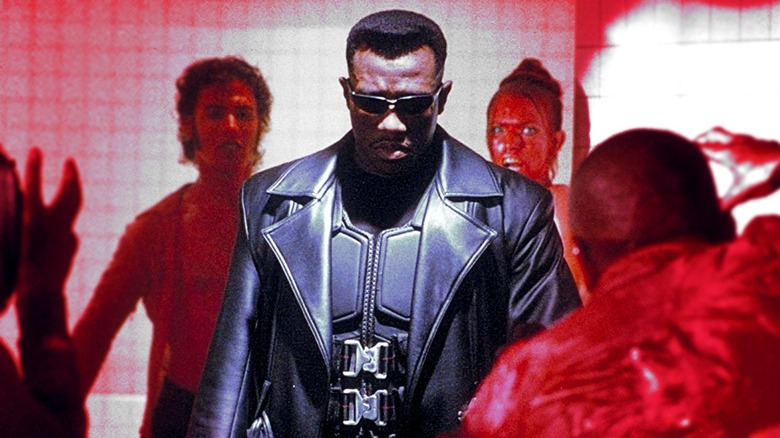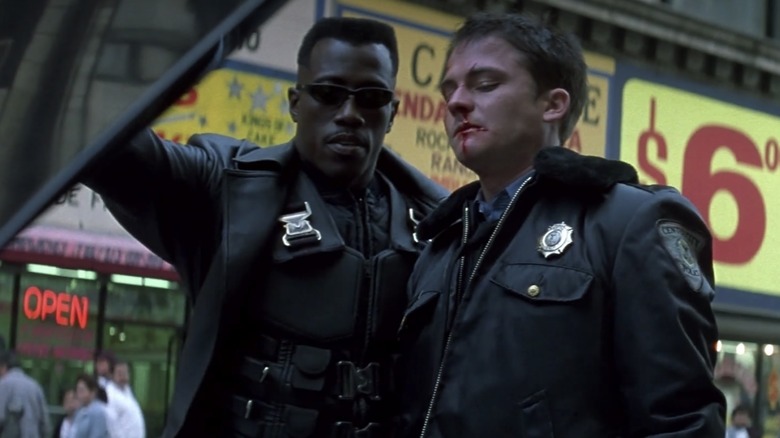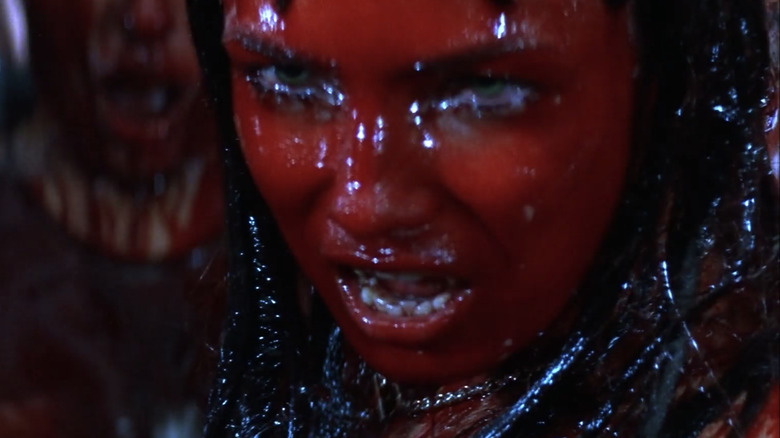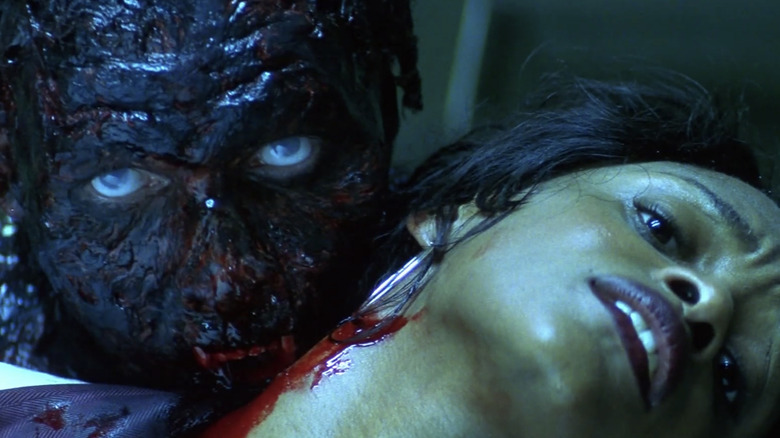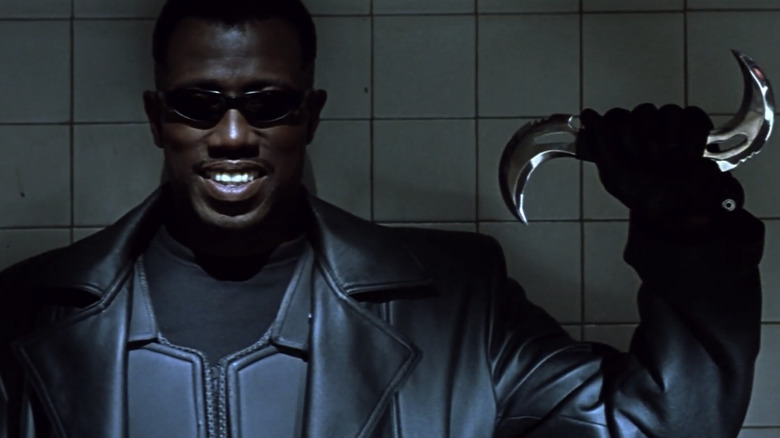Year Of The Vampire: Blade Day-Walked So Other Superheroes And Vampire Hunters Could Run
(Welcome to Year of the Vampire, a series examining the greatest, strangest, and sometimes overlooked vampire movies of all time in honor of "Nosferatu," which turns 100 this year.)
In 1998, a year before "The Matrix" and two years before the first live-action "X-Men" movie, a superhero arrived in a trench coat, black leather, and dark shades, ready to kill some vampires. His name was "Blade," and he was played by Wesley Snipes. But you already know that because He Is Legend: not quite "The Last Man on Earth," but certainly the last line of defense against big-screen vampires at the turn of the millennium.
While "Buffy the Vampire Slayer" was holding down the Hellmouth in her TV neighborhood of Sunnydale, California, Blade was keeping hope alive for heroes and humans in a fictional metropolis. Blade is a Daywalker, half-human, half-vampire, all attitude.
David S. Goyer's script begins with Blade in utero as Eric Brooks in a hospital's trauma ward: "It's 1967, the Summer of Love and — BOOM! Entry doors swing open as PARAMEDICS wheel in a FEMALE BLEEDER." This is Blade's mother. A vampire bit her while she was pregnant, and while her son will grow up with the thirst for blood, he'll still retain some of his humanity and be able to walk in sunlight.
In the real world, 1967 was two years out from the "Summer of Soul," the "Black Woodstock" you maybe never heard about until last year because, as the subtitle of last year's documentary tells us, it happened "When the Revolution Could Not Be Televised." As we continue to commemorate the Year of the Vampire — and Black History Month — it's worth remembering the lesson HBO's "Watchmen" taught us. The world's first superhero, or in this case, the vampire-hunting forerunner of the Marvel movie millennium, was Black.
What It Brought To The Genre
Has there ever been a vampire hunter who was a bigger badass than Blade? That's a rhetorical question because the answer is no.
Directed by Stephen Norrington, "Blade" infused the vampire film tradition with some good old-fashioned action heroism, at a time when pop culture as a whole was on the cusp of a new Golden Age of TV, rife with antihero dramas. So often over the last century of vampire cinema, we've seen humans at the mercy of bloodsuckers. On the news and in viral videos, we've also seen waves of protests and Black lives snuffed out by police brutality.
Blade is no vampire's victim. Neither is he a victim of Officer Krieger (Kevin Patrick Walls), that one weaselly white cop with the glyph on back of his neck, branding him like cattle as a vampire's familiar.
I'm not trying to conflate all cops with vampires. I'm just saying there are multiple scenes in "Blade" where the aspirational Black hero gives one bad cop his comeuppance, throwing him around and calling him a "vampire wannabe." Officer Krieger serves Deacon Frost (Stephen Dorff), an upstart bloodsucker who is so evil that he will expose his vampire elders to the sun and even turn Blade's own aforementioned mother, Vanessa (Sanaa Lathan), against him.
The world-building in "Blade" is on point. The movie immediately thrusts us into a cityscape where vampires roll human bodies through a meat packing plant as if they were sides of beef. They lead guys like lambs to the slaughter in raves where the fashion sense is "Matrix" (but again, pre-"Matrix") and where blood sprinklers shower bloodsuckers on the dance floor. Yet the minute Blade shows up, the vampires scatter like cockroaches. There's just one of him but he has no compunctions about striding into a night club full of the undead.
To Be A Vampire Hunter Among Vampires
Abraham Whistler (Kris Kristofferson) is the grizzled, grey-bearded, biker-type mentor and weaponeer we all need. He's there to dose the Daywalker with a serum that suppresses his blood appetite and he's there to sloppily gas his Blade-mobile in their garage/Blade-cave while lighting up a cigarette right next to it. Whistler also outfits the human hematologist Karen Jenson (N'Bushe Wright) with some vampire mace, "Silver nitrate, essence of garlic."
"Blade" contains some other creative flourishes, like the torture of a vampire blob named Pearl with a UV lamp, and the use of sunblock and motorcycle helmets by bloodsuckers in daytime or at daybreak. Some aspects of the movie are admittedly cheesy, none more so than the "blood god" special effects toward the end. However, "Blade" is an exception to the rule that the real star of most vampire movies is the monsters themselves. If I had a child, my only hope for them in this world would be that they could learn to be a vampire hunter among vampires, like Blade.
Sometimes vampires are scary, and sometimes, as in the case of the blood raver Racquel (Traci Lords), they're dangerously alluring. Either way, Hollywood usually puts them front and center as an inhuman threat or a seductive love interest — if not the outright main character.
The 2010s were particularly weighted toward the vampire's perspective, with films such as "Only Lovers Left Alive," "What We Do in the Shadows," and "A Girl Walks Home Alone at Night" foregrounding a new breed of undead protagonists. Donal Logue, who plays Quinn, the toasted vamp who comes back to life in the hospital in "Blade," appeared in the season 3 finale of the "What We Do in the Shadows" TV series last year, while Snipes himself made a Skype appearance in season 1.
The Superhero Vampire Hunter
It feels like Blade and Buffy provided the last great gasp of hunter and slayer narratives before the reign of the vampire antihero set in. Yet Blade was always the best of both worlds, a character who could walk the line between day and night, human and vampire. In the 2020s, he still inspires kids and other would-be vampire hunters, as seen in the Netflix horror comedy, "Vampires vs. the Bronx."
In the same way that Blade himself is a vampire-human hybrid, his film has one foot in the vampire movie genre and one foot in the superhero genre. Two decades before "Blade," Christopher Reeve made moviegoers believe a man could fly in "Superman." After four films, however, the Superman series had run its course. Furthermore, a horse-riding accident in 1995 tragically left Reeve paralyzed and confined to a wheelchair.
The "Batman" film series, meanwhile, had cycled through Michael Keaton, Val Kilmer, George Clooney, and four movies of its own. It entered a fallow period after "Batman and Robin" in 1997 and would only come back to life (rather like an undying vampire-turned-bat) when Christopher Nolan rebooted it in the mid-2000s with "Batman Begins."
In a world without Superman and Batman, Blade stepped up to lead the way for Marvel. He was there, slicing and dicing bloodsuckers in the first halfway decent Marvel movie, 10 years before "Iron Man" and the birth of the MCU, and 20 years before "Black Panther" and the first Best Picture nomination for a superhero film at the Academy Awards.
Now, after 27 movies and counting, Marvel Studios is finally coming back around to Blade with an upcoming MCU-set film starring Mahershala Ali. Unless you've been living under a rock or sleeping in a coffin, you've probably heard by now that Ali has already made his debut in the MCU by way of a voice cameo.
Respect For Blade
In "Blade II," director Guillermo del Toro took himself out of the vampire clock shop, as seen in "Cronos," and down into the sewers with the Daywalker to face a more terrifying breed of vampires with stretchy mouths. The director would return to vampire subject matter — with some long-tongued Strigoi in tow — as he helped launch "The Strain," the FX series about the outbreak of a vampire virus in New York. This brought the genre back to its "Nosferatu" roots, delivering plague-inflected screen horrors when the globe was only a few years removed from a real pandemic. Instead of COVID-19, the people of that time had been dealing with the 1918 Spanish flu.
In "Blade: Trinity," what should have been a slam-dunk concept — Blade vs. Dracula — wound up being a notoriously fraught production, as Goyer transitioned to writer-director and his friendship and four-movie collaboration with Snipes hit the skids. (He also worked with Snipes between "Blade" movies in his 2002 directorial debut, "Zig Zag.")
I wasn't there on the set to witness what really happened, but just as a thought experiment, put yourself in the shoes of a Black movie star, surrounded by an all-white cast, in the final installment of a trilogy with your character's name on it. Suddenly, like many a lead actor in today's mighty Marvel landscape, you're no longer the star of your own movie, but rather one member of a team of Nightstalkers. Some of your costars are comedians who will take the piss out of you with jokes and then tell stories later about how difficult it was working with you. You've had your efforts to foster a more diverse cast and crew stymied, and one day, you come out of your trailer to find the only other Black guy in the movie wearing a shirt emblazoned with the word "Garbage."
It feels like that kind of atmosphere (allegedly strangling your director, too) wouldn't fly in Hollywood circa 2022. It also feels like a lot of today's superheroes — and vampire hunters — might never have gotten any momentum going were it not for Blade and his success. Blade day-walked so they could run.
